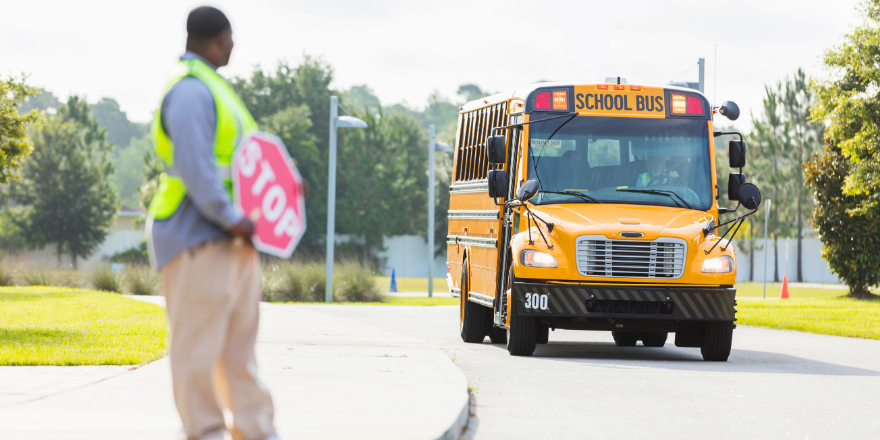As part of National School Bus Safety Week, we’re discussing the importance of safety collaboration and outlining some of the ways contractors can actively work with community stakeholders to develop safer transportation programs for our “precious cargo.”
Contractor and driver efforts
School bus drivers – the HEROES of our organization – undergo extensive training before they’re allowed to transport students, and they receive additional safety training on a regular basis. As an example, our partner contractor in Pennsylvania, Krise Transportation, holds safety meetings that cover a range of topics. Additionally, PennDOT offers tips on its website that can help bus drivers operate more safely, including:
- Always do a pre-trip inspection before every run to check for mechanical defects.
- Per Pennsylvania law, children are never allowed to stand while the bus is in motion, and can never block bus aisles or emergency exits.
- Always follow Operation Lifesaver’s “Five Alive” process when approaching a railroad track.
- When unloading, make sure all children are in a safe place before deactivating your light system and moving the school bus.
- Do not allow children to exit the bus before all traffic has come to a complete stop and safety equipment has been engaged.
- After unloading all children at the school or after your last stop, do a post-trip inspection and make sure no child has been left on the bus.
- Be prepared to act swiftly and appropriately in emergency situations.
Safety tips for students and parents
One of the primary benefits of a collaborative approach to safety is the chance to connect with students to foster safer bus behavior.
These safer practices aren’t limited to the time students are actually on the bus, but extend to the entire journey from home to school and back. School bus contractors can involve parents and students in the safety equation, sharing basic principles that help build a culture of responsibility and respect. School bus safety tips for students include:
- Arrive at your school bus stop five minutes early. By not being rushed, you can pay better attention to traffic and avoid running across the street to catch your bus.
- While waiting, stay at least five giant steps away from the curb or the road.
- Never speak to strangers at the bus stop and never get into a car with a stranger.
- Don’t run after the school bus if it has already left the bus stop.
- Stay in your seat when the bus is moving, and never put your head, arms, or hands out the window.
- Follow your school bus driver’s instructions, so they can make safe decisions.
- Never play with the emergency exits, and make sure backpacks, band instruments, or sports equipment never block the aisle or emergency exits.
- Don’t push when getting on or off of the school bus.
- Talk quietly so you don’t distract your driver.
- When getting off of the school bus, make sure drawstrings, backpacks, and other objects are secure so they don’t get caught on the handrail or the door.
- Wait until all traffic has stopped and you have the okay from your driver before stepping out onto the road – and always walk at least 10 feet in front of the bus when crossing so your driver can see you.
- If you leave something on the bus or drop something outside of the bus, don’t go back for it! Your driver may not see you and begin to move.
School district involvement
School staff and administrators can partner with contractors to build a culture of safety on and off the school bus. Areas where an effective contractor-district partnership can make a big impact include:
Communication and feedback
Communication channels can include email, phone, or social media that provide a clear point of contact for sharing safety updates or concerns. By providing access and encouraging open dialogue, school bus contractors can respond more efficiently, providing better service to the community.
Emergency preparedness
Contractors can work with school districts to plan drills and provide training that helps students and drivers respond appropriately in the event of an emergency. Consider developing a working group comprised of representatives from the school bus contractor, district staff, parents, and even student council members to share knowledge and develop strategies to enhance existing safety measures.
Student engagement
School bus contractors and district staff can develop age-appropriate bus safety programs for students. These programs could include classroom presentations or interactive activities to teach students about proper bus behavior, such as the annual National School Bus Safety Week Poster Contest, with winners announced in October.
Safety begins with teamwork
Safety is a collective responsibility, and expert school bus contractors recognize the importance of collaboration with school districts, students, and parents to create a safe and secure school transportation environment. Through collaborative safety programs, students learn valuable life skills, and the entire community benefits from enhanced safety awareness and practices.
Contact us
If you’re a school bus contractor seeking growth, reach out to us. We’d love to hear from you.
American Student Transportation Partners (ASTP) is a dynamic network of safe, dependable student transportation providers. We’re driving the future of student transportation by providing access to education through reliable, efficient student transportation programs. Exceptional bus operators choose ASTP because of our innovative approach to partnership, as well as the resources we provide to help “future-proof” their operations.
To learn more about partnering with ASTP, contact Tod Eskra, President, at [email protected] or call (314) 560-5946.

